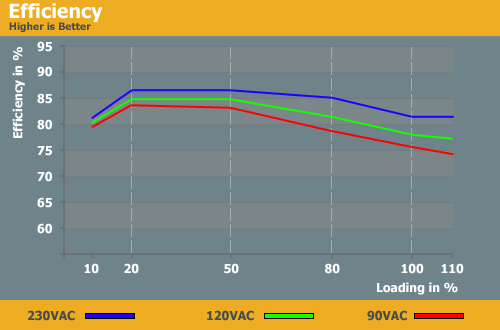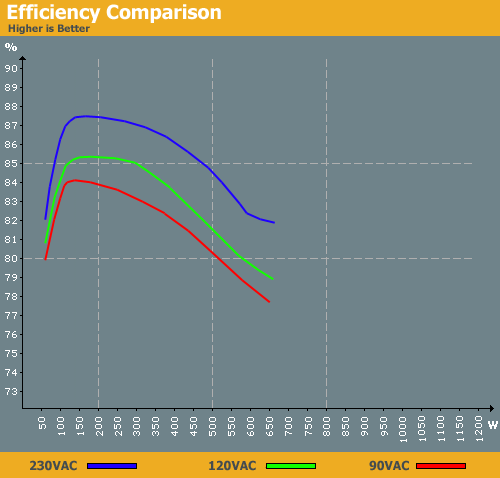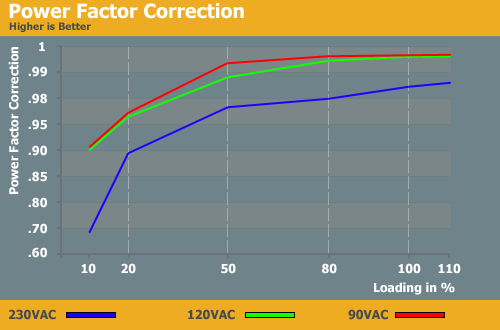Cooler Master Silent Pro PSUs
by Christoph Katzer on September 8, 2008 3:00 AM EST- Posted in
- Cases/Cooling/PSUs
Efficiency and PFC



The efficiency is good, and with 230VAC it stays above 82% throughout testing. The maximum of 87% efficiency of the 600W unit is better than the 500W model, which only makes it up to 86%. Given the nearly identical design, we were a little surprised to see any differences at all in the efficiency curves. The 500W curves look similar to what we normally see, but the 600W unit is a little odd. It performs extremely well in the first half of the output curve, from a low input of 130W to 400W, but then it drops rapidly and eventually falls into the sub-80% range with 120VAC/90VAC. Normally, we don't see efficiency drop much lower than the initial values. The 600W model still performs better than the 500W unit overall, but it runs optimally in the 130W to ~350W range.

The power factor correction is also a little strange, since it starts at a really low value and stays lower than normal with 230VAC. Lower input voltage means better PFC and the result improves, getting close to .994 which is not bad.










15 Comments
View All Comments
ryboto - Wednesday, September 17, 2008 - link
You're quite incorrect. The method for heat transfer from the heatsinks to the air is the same for both copper and aluminum. If you took a heat transfer course you'd know that the thermal conductivities and convective heat transfer coefficients are what is used in the heat transfer equations. No where is it dependent on the heat capacity. So, you haveQ=K A (Tb-Th) where Tb=base temp, Th= heatsink temp, then heat transfer to the air is
Qa=h A (Th-Ta) where Ta is the bulk air temp. These are highyl approximated, as there are multiple layers. Now, look at the equations...if K for Cu is greater than for Al, heat transfer is faster. What this amounts to is a greater Th, but look at the second equation, if Th is greater, the temperature gradient(or driving force for heat transfer) is greater than it would be for aluminum. Copper is a better material for this application. It's just expensive, and it oxidizes, which is why we have nickel plated copper heatpipes.
Megaknight - Tuesday, September 9, 2008 - link
Great explanation mate.Penti - Monday, September 8, 2008 - link
It's an old tale but it's just that a tale.Weight has probably a lot to do with it on modern coolers, I have a Tuniq Tower 120, think of this cooler in pure copper, it would snap the motherboard with it's weight probably. We haven't moved to coolers weighing 2-3 kg yet. But as always price is the main factor.
Aquila76 - Monday, September 8, 2008 - link
'Transfer' and 'dissipate' are different things. The copper plates transfer heat away from the components better; the aluminum fins dissipate (exchanges may have been a better word choice there) the heat into the air. This is not unlike those heatpipe tower-style CPU coolers.Christoph Katzer - Monday, September 8, 2008 - link
Thanks mate.